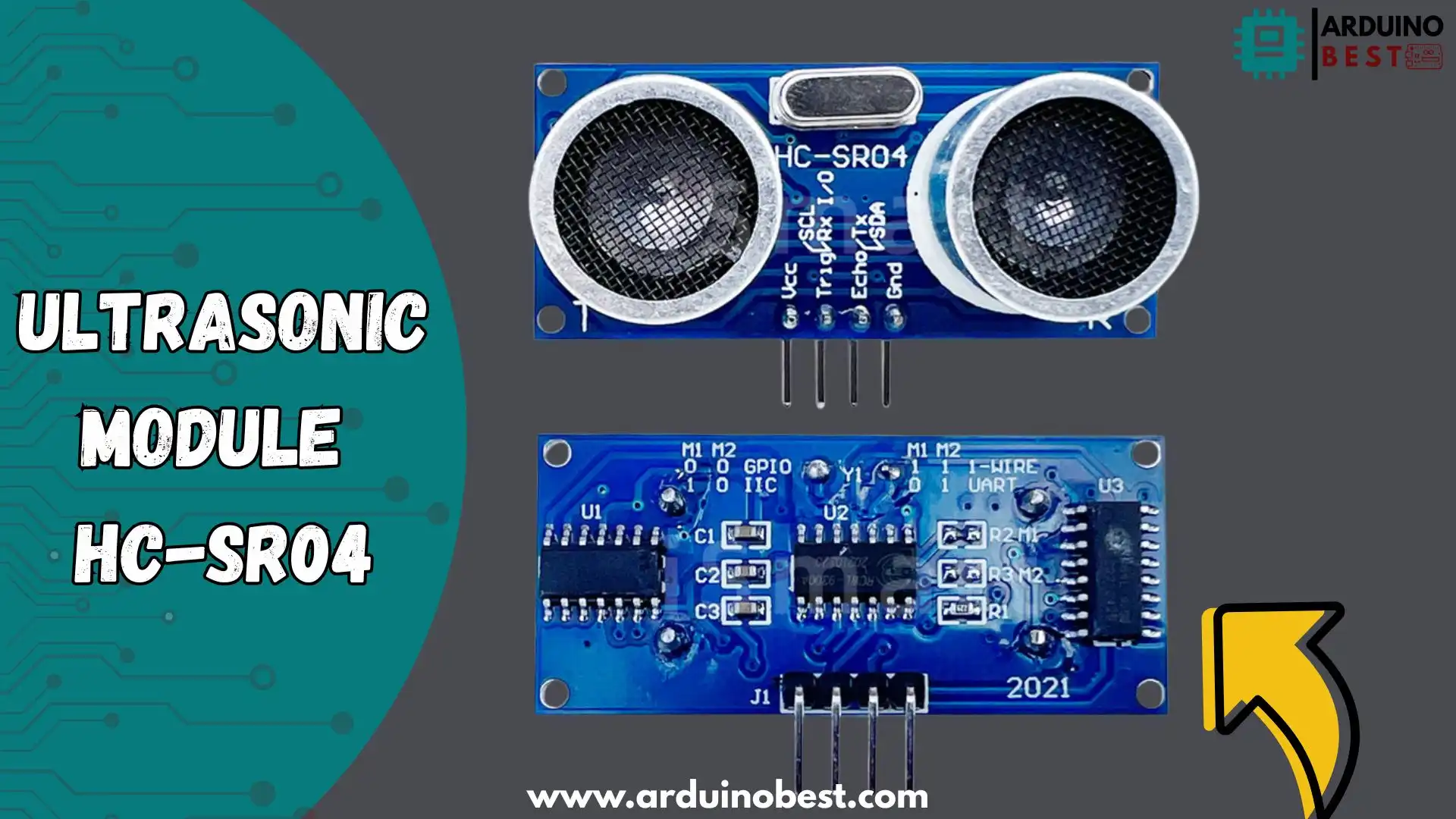Table of Contents
Ultrasonic sensors like the Ultrasonic Module HC-SR04 are integral components in a variety of electronics projects. From simple proximity sensing in robotics to complex automation systems, the HC-SR04 sensor offers an affordable, reliable, and precise way to measure distances using sound waves. The simplicity and versatility of this sensor have made it a popular choice among hobbyists, engineers, and makers. In this article, we’ll explore everything you need to know about the HC-SR04 ultrasonic sensor, how it works, and how to integrate it into your projects.
For a deeper dive into ultrasonic sensor technology, check out this Ultrasonic Sensor Principles guide.
What is the HC-SR04 Ultrasonic Sensor?
The HC-SR04 ultrasonic sensor is a device that uses sound waves to measure distances to objects. It works by emitting an ultrasonic pulse and measuring how long it takes for the sound wave to bounce back after hitting an object. The sensor then calculates the distance based on the time it took for the pulse to return.
- Basic components:
- Transmitter: Sends out ultrasonic pulses.
- Receiver: Receives the echo of the ultrasonic waves.
- Control module: Processes the time delay and calculates the distance.
With a range of 2cm to 4 meters and an accuracy of around 3mm, it is ideal for applications where precise distance measurement is crucial.
For detailed information on wiring and implementation, you can check this Arduino Ultrasonic Sensor Guide.
How the HC-SR04 Ultrasonic Module Works
The HC-SR04 operates on the principle of echo pulse technology, which involves sending a pulse of sound and then measuring the time it takes for the echo to return. Here’s a step-by-step explanation:
- Emit Pulse: The sensor’s transmitter emits an ultrasonic pulse at a frequency of 40 kHz.
- Echo Reception: When this pulse hits an object, it bounces back to the sensor’s receiver.
- Time Calculation: The control module measures the time between sending the pulse and receiving the echo.
- Distance Calculation: Using the formula Distance=Time×Speed of Sound2\text{Distance} = \frac{{\text{Time} \times \text{Speed of Sound}}}{2}, the distance to the object is calculated.
This process is quick and provides reliable readings for a wide range of applications.
Components of the HC-SR04 Ultrasonic Sensor
Understanding the components of the HC-SR04 sensor can help you troubleshoot, customize, and enhance its functionality in your projects.
- Transmitter (Trigger Pin): Sends the ultrasonic pulse.
- Receiver (Echo Pin): Detects the reflected sound waves.
- Control Module: Calculates the time taken for the echo to return and determines the distance.
These components work together to provide a precise measurement of distance.
How to Use the HC-SR04 Ultrasonic Module with Arduino
Integrating the HC-SR04 ultrasonic module with an Arduino is one of the most popular ways to use this sensor. Below is a simple guide to get you started:
Wiring the HC-SR04 to Arduino:
- VCC pin of the HC-SR04 connects to the 5V pin of Arduino.
- GND pin of the HC-SR04 connects to the GND pin of Arduino.
- Trig pin of HC-SR04 connects to Digital Pin 9 of Arduino.
- Echo pin of HC-SR04 connects to Digital Pin 10 of Arduino.
Arduino Code Example:
Here’s a simple code snippet to get your sensor working:
#define trigPin 9
#define echoPin 10
long duration;
int distance;
void setup() {
Serial.begin(9600);
pinMode(trigPin, OUTPUT);
pinMode(echoPin, INPUT);
}
void loop() {
digitalWrite(trigPin, LOW);
delayMicroseconds(2);
digitalWrite(trigPin, HIGH);
delayMicroseconds(10);
digitalWrite(trigPin, LOW);
duration = pulseIn(echoPin, HIGH);
distance = duration * 0.034 / 2;
Serial.print("Distance: ");
Serial.println(distance);
delay(500);
}
The code sends a signal to the Trig pin and measures the time the Echo pin takes to return. This time is used to calculate the distance.
Troubleshooting:
- Sensor not detecting correctly? Check your wiring and ensure the Echo and Trig pins are connected to the correct digital pins.
- Inconsistent measurements? Verify the distance and environmental conditions like temperature, which can affect sound speed.
Key Applications of the HC-SR04 Ultrasonic Sensor
The HC-SR04 sensor has diverse applications in various fields, including:
- Robotics: Used for obstacle avoidance and navigation.
- Autonomous Vehicles: Enables distance measurements for accurate decision-making.
- Level Measurement: Monitors liquid levels in tanks.
- Home Automation: Detects proximity for smart home systems.
- Security Systems: Measures distances for motion detection.
Advantages of Using the HC-SR04 Ultrasonic Sensor
Here’s why the HC-SR04 is a popular choice:
- Low Cost: One of the most affordable distance sensors available.
- Easy to Use: Simple wiring and easy integration with platforms like Arduino and Raspberry Pi.
- Wide Range: Can detect distances from 2 cm to 4 meters with decent accuracy.
- Low Power Consumption: Suitable for battery-powered devices.
- Versatile: Ideal for a wide range of applications including robotics, IoT, and automation.
Common Challenges and Troubleshooting for HC-SR04
Like any sensor, the HC-SR04 is prone to certain issues, such as inaccurate distance readings. Some common challenges and their solutions include:
- Incorrect readings: Ensure that the sensor is calibrated correctly and the echo pin is reading properly.
- Low range: Try increasing the power supply voltage or using external power sources.
- Temperature issues: The speed of sound can vary with temperature, so adjusting for temperature changes may improve accuracy.
Advanced Use Cases and Projects with HC-SR04
As you get more familiar with the HC-SR04 ultrasonic sensor, you can explore more advanced applications:
- Smart Home Lighting: Use proximity sensors to automatically turn on lights when you approach.
- Agricultural Drones: Use the HC-SR04 for measuring the altitude or distance between crops.
- Healthcare: Create systems for monitoring distances for safe patient movements.
- Industrial Automation: Automate machines with proximity and distance sensing.
HC-SR04 vs Other Ultrasonic Sensors
While the HC-SR04 is great for many applications, it is not the only ultrasonic sensor available. Here’s how it compares to other sensors:
- JSN-SR04T: A waterproof alternative, ideal for outdoor use, but typically more expensive.
- SRF05: Similar performance to HC-SR04, but with different pin configurations.
- MaxBotix: Offers more accurate and longer-range sensors but at a higher price point.
FAQs
1. How accurate is the HC-SR04 ultrasonic sensor?
The HC-SR04 offers accuracy within ±3 mm, making it suitable for many applications where precise distance measurement is required.
2. What is the maximum range of the HC-SR04?
The maximum range is 4 meters, with the minimum range being around 2 cm.
3. Can the HC-SR04 be used with Raspberry Pi?
Yes, the HC-SR04 can be easily used with Raspberry Pi by connecting the Echo and Trigger pins to GPIO pins.
4. How can I extend the range of the HC-SR04 sensor?
You can extend the range by using better power supplies or adding additional sensors for longer-range measurement.
5. Is the HC-SR04 sensor waterproof?
No, the HC-SR04 is not waterproof. For outdoor or rugged applications, consider using the JSN-SR04T sensor, which is designed for waterproof use.
Conclusion
The HC-SR04 ultrasonic module is a versatile and cost-effective sensor that plays a crucial role in distance measurement and proximity sensing. Its ease of use, along with its compatibility with platforms like Arduino, makes it a popular choice for both beginners and experienced hobbyists alike. Whether you’re building a robot, a smart home device, or an industrial automation system, this sensor can provide accurate distance readings in real-time.
By understanding the working principles of the HC-SR04 and learning how to properly integrate it into your projects, you can unlock its full potential for a wide range of applications. Additionally, knowing how to troubleshoot common issues like signal interference and voltage fluctuations will ensure that your projects run smoothly.
Ultimately, the HC-SR04 ultrasonic module’s reliability, simplicity, and affordability make it an indispensable tool for anyone working in electronics or robotics. Whether you’re experimenting with new ideas or developing complex systems, this sensor is an essential addition to your toolkit, offering endless possibilities for innovation.
Arduino Projects:
1- Complete Guide for DHT11/DHT22 Humidity and Temperature Sensor With Arduino
2- DHT11 – Temperature and Humidity Sensor
3- DHT22 – Temperature and Humidity Sensor (more accurate than DHT11)
4- BMP180 – Barometric Pressure and Altitude Sensor
5- BMP280 – Barometric Pressure & Temperature Sensor
6- BME280 – Temperature, Humidity, and Pressure Sensor
7- Arduino Flex Sensor Controlled Robot Hand
8- Arduino ECG Heart Rate Monitor AD8232 Demo
9- Arduino NRF24L01 Wireless Joystick Robot Car
10- Arduino Force Sensor Anti-Theft Alarm System
11- Arduino NRF24L01 Transceiver Controlled Relay Light
12- Arduino Rotary Encoder Controlled LEDs: A Complete Guide

